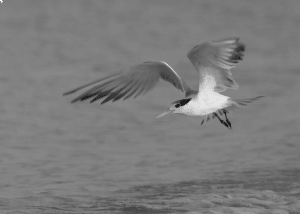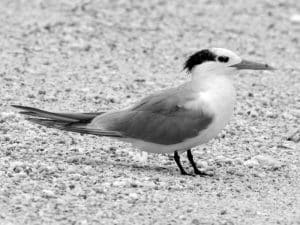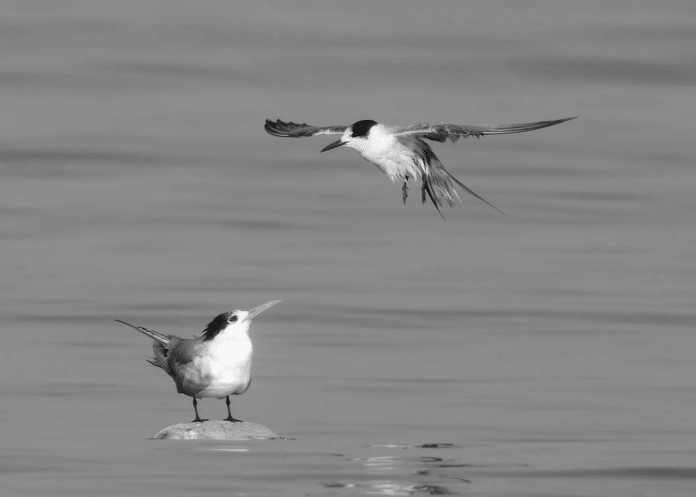Introduction to the Lesser Crested Tern
The Lesser Crested Tern, also known by its scientific name Thalasseus bengalensis, is a stunning seabird that can be found in various coastal areas around the world. In this article, we will focus specifically on the Lesser Crested Tern in Tanzania, a country renowned for its breathtaking coastal beauty. From its habitat and distribution to its migration patterns, behavior, and conservation status, we will explore the fascinating aspects of this magnificent bird’s life in Tanzanian coastal areas.
Lesser Crested Tern’s Habitat and Distribution

The Lesser Crested Tern is primarily found in coastal regions, including beaches, estuaries, lagoons, and islands. In Tanzania, it can be spotted along the coastline of the Indian Ocean, from the border with Kenya to the border with Mozambique. These birds are known to prefer sandy and rocky shores for nesting and foraging. They are also highly adaptable and have been observed in urban coastal areas, such as Dar es Salaam, where they often nest on rooftops and other man-made structures.
Lesser Crested Tern’s Migration Patterns
The Lesser Crested Tern is a migratory bird, and its movements are influenced by seasonal changes and the availability of food. During the breeding season, which typically occurs between October and March, these terns can be found in Tanzania. However, as the seasons change, they embark on long-distance journeys to their non-breeding grounds. Some individuals have been recorded traveling as far as South Asia and the Middle East. These migratory journeys highlight the incredible stamina and navigational abilities of the Lesser Crested Tern.
Lesser Crested Tern’s Behavior and Characteristics
The Lesser Crested Tern is a graceful bird with distinct features. It measures around 35 centimeters in length, with a wingspan of about 70 centimeters. The adults have a black crown and nape, contrasting with a white forehead and underparts. They also possess a distinctive black crest during the breeding season. The juveniles, on the other hand, have a mottled brown appearance. These terns are known for their agile flight and their ability to dive into the water to catch fish. They are sociable birds and often gather in large flocks, especially during migration.
Lesser Crested Tern’s Conservation Status

The conservation status of the Lesser Crested Tern is a matter of concern due to various threats it faces in its natural habitat. Habitat destruction, pollution, disturbance from human activities, and climate change all pose significant risks to the survival of these birds. The International Union for Conservation of Nature (IUCN) has classified the Lesser Crested Tern as a “Near Threatened” species. This designation emphasizes the urgency of implementing conservation measures to protect their habitats and ensure their long-term survival.
Discovering the Coastal Beauty of Tanzania
Tanzania is renowned for its stunning coastal areas, which are home to a rich diversity of marine and birdlife. From the pristine beaches of Zanzibar to the mangrove forests of the Rufiji Delta, the country offers a unique and captivating experience for nature enthusiasts. Exploring the coastal beauty of Tanzania provides an opportunity to witness not only the mesmerizing landscapes but also the incredible biodiversity that thrives in these ecosystems.
Lesser Crested Tern’s Presence in Tanzanian Coastal Areas
Tanzania’s coastal areas serve as an important habitat for the Lesser Crested Tern. These graceful birds can be observed along the shores, soaring in the sky, or diving into the crystal-clear waters in search of prey. They are particularly abundant in areas such as Saadani National Park and Bagamoyo, where their nesting sites are protected. Witnessing their aerial acrobatics and hearing their distinctive calls is a true spectacle that showcases the natural wonders of Tanzania’s coastline.
Observing the Lesser Crested Tern in Its Natural Habitat
To fully appreciate the beauty of the Lesser Crested Tern, it is essential to observe them in their natural habitat. Guided eco-tours and boat trips offer opportunities to get up close and personal with these magnificent birds. As you sail along the coastline, keep your eyes peeled for their elegant flight patterns and their characteristic plunge-dives into the ocean. The sight of a flock of Lesser Crested Terns gracefully skimming the water’s surface is a sight you will never forget.
Lesser Crested Tern’s Breeding Grounds in Tanzania

Tanzania is not only a wintering ground for the Lesser Crested Tern but also an important breeding site. The terns choose sandy beaches and islands to establish their nests, laying their eggs directly on the ground or on shallow scrapes. These breeding sites are carefully selected to provide protection from predators and disturbances. It is crucial for visitors to respect these nesting areas and maintain a safe distance to ensure the terns can successfully raise their young.
Conservation Efforts and Initiatives for the Lesser Crested Tern in Tanzania
Recognizing the importance of conserving the Lesser Crested Tern and its coastal habitat, Tanzania has implemented several initiatives to protect these birds. National parks and marine reserves have been established to safeguard their nesting sites and feeding grounds. Local communities are also actively involved in conservation efforts, participating in awareness campaigns and supporting sustainable tourism practices. These collective actions play a vital role in ensuring the long-term survival of the Lesser Crested Tern and preserving the ecological balance of Tanzania’s coastal ecosystems.
Conclusion: Appreciating the Beauty and Importance of the Lesser Crested Tern in Tanzania’s Coastal Ecosystem
The Lesser Crested Tern’s Tanzanian sojourn is a testament to the country’s remarkable coastal beauty and the significance of its ecosystems. These graceful birds bring life and vibrancy to the shores, captivating both locals and visitors alike. By understanding their habitat, behavior, and conservation needs, we can appreciate the importance of protecting these magnificent creatures and the diverse coastal ecosystems they call home. So, next time you find yourself gazing at the turquoise waters and sandy beaches of Tanzania, remember to keep an eye out for the Lesser Crested Tern and marvel at its elegance and resilience. Let us join hands to safeguard their future and preserve the coastal beauty of East Africa for generations to come.


































